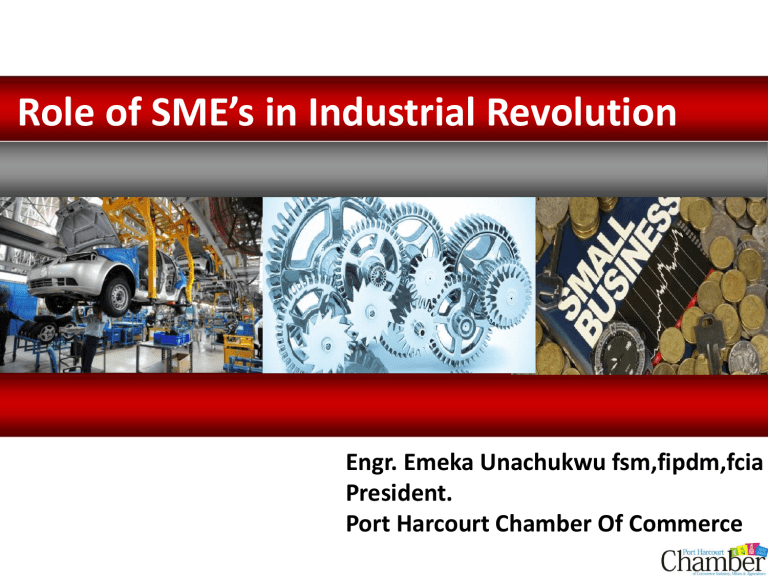
Role of SME’s in Industrial Revolution Engr. Emeka Unachukwu fsm,fipdm,fcia President. Port Harcourt Chamber Of Commerce Epilogue A tale of three companies & Three Countries Exxon Mobil’s revenue > Pakistan’s GDP 2008 (95,000 employees) (141 million population) General Motors > New Zealand General Electric > Nigeria 12 Feb 2014 Why are we here? Dateline -11th February 2014 12 Feb 2014 Jonathan Launches NIREP, NEDEP Understanding the Plan NIRP Nigeria Industrial Revolution Plan NEDEP National Enterprise Development Programme Transform the nation’s industrial landscape, Boost skills development, Enhance job creation Conserve foreign exchange Programme Focus NIRP Nigeria Industrial Revolution Plan NEDEP National Enterprise Development Programme Agriculture and agro-products Metals and solid minerals, Oil and gas, Construction, Light manufacturing services Programme Focus NIRP Nigeria Industrial Revolution Plan NEDEP National Enterprise Development Programme Address all the major physical constraints impeding industrialisation Improve the nation’s investment climate Promote the patronage of made-inNigeria products. Programme Focus NIRP Nigeria Industrial Revolution Plan NEDEP National Enterprise Development Programme Increase Manufacturing sector GDP from 4% to 10% in 5years Boost the annual revenue earnings of the Nigerian manufacturers by up to N5 trillion per annum Make SME’s major driver of job creation and inclusive economic growth. Defining Industrialization The transition of an economy from primarily agrarian to one based mainly on manufacturing and industry. Defining Industrialization Defining SME’s SME’S MSME’S @ 10-50 million Micro 98% Small 1% Meduim 1% Employees Turnover (annualN) Turnover (annualUSD**) AssetValue (N) AssetValue (USD) Micro 0-10 0– 10million 0–65000 5million 32000 Small 10-49 10-100 million 65000– 650000 5-50million 32000– 320000 50-199 100-500 million 650000– 3.2million 50–500 million Medium 320000– 3.2million Why are SME’s Important SMEs contributes 50% of GDP …..(OECD). 65% of employment in high income countries are from SMEs. SMEs generate 70% - 90% of employment in middle income countries. Significant impact on the export earnings in developing countries. SMEs enhances entrepreneurship innovation and invention Why are SME’s Important SMEs drive technology change and growth in productivity Catalyst to private sector development According to IFC, 96% of business in Nigeria fall under SMEs 90% of manufacturing and industrial sector in numbers fall under SMEs. Why are SME’s Important Agencies that support SME’s Small & Medium enterprises credit Guarantee Scheme (SMECGS) of CBN. Small & Medium Industries Equity Investment Scheme (SMIEIS) of CBN. Family Economic Advancement Program (FEAP) Industrial Development and Coordinating Centre. National Directorate of Employment Nigerian Bank for Commerce & Industries (NBCI) Agencies that support SME’s Nigerian Industrial Development Bank (NIDB) National Economic Reconstruction Fund (NERFUND) The African Development Bank / Export Stimulation Loan (ADB/ESL) Nigerian Export Import Bank Microfinance Banks Bank of Industry (BOI) Small & Medium enterprises Development Agency of Nigeria (SMEDAN). Understanding SME’s How SME’s support Industries How SME’s support Industries Important source of local supply and service provision to larger corporations Extensive local knowledge of resources, supply patterns and purchasing trends By working closely with SMEs, large corporations can develop a new customer base that may not be accessible to the traditional distribution networks of these corporations. Important source of innovation – SMEs tend to occupy specialized market “niches” and follow competitive strategies that set them apart from other companies Examples from other Countries Brazil/South Africa DaimlerChrysler: local and sustainable sourcing of raw materials for automobile production. India/Unilever: employing women entrepreneurs to distribute health and hygiene products locally (India) Azerbaijan/BP: enterprise center to build capacity and create employment among local companies) South Africa/Vodafone: co-investing with local entrepreneurs t o establish phone kiosk ABN Amro and GE: providing microcredit and finance to SMEs Case Study – Industrialized Nation Case Study – JAPAN Backbone of Japan’s Economy 99.7% of all Enterprises, 70% of Employees, 50% of the amount of value-added (in the manufacturing industry Case Study – JAPAN Creating new industries & transforming industrial structure Toyota, Honda, and Sony all started as back street factories Case Study – JAPAN Supporting Big Companies All parts consumed by the big companies are produced by SME’s Reliability of Japanese products Case Study – JAPAN Revitalizing Local Economy & Increasing Employment Great support to service, construction and retail industry; Case Study – JAPAN “SMEs energize Japan’s future!” The Government Policy implementation organization for management support in SME sectors. HokkaidoHeadOffice ● Our nationwide support network 9 Regional Head Office & 9 SME universities Approx. 800 employees TohokuHeadOffice Over 3000 registered experts HokurikuHeadOffice (ex. lawyers, CPAs, tax accountants, management consultants, etc.) Kanto HeadOffice ChugokuHeadOffice ● Features of our support Multiple/comprehensive support ChubuHeadOffice KyushuHeadOffice KansaiHead Office ShikokuHeadOffice Hands-on support Extensive/high-quality support utilizing the networks Matsuyama Office 5 Conclusion Why Nigeria SME’S May Not Play Effectively Support the Industrial Revolution Lack of Management Competence 16% Poor Management of Financial Activities 34% Inflation & Economic Union Conditions Problems 6% 12% Poor Bookkeeping & Records 12% Sales & Marketing Problems 11% Staffing Problems 9% Thanks for Listening Engr. Emeka Unachukwu President Port Harcourt Chamber Of Commerce emeka.unachukwu@gmail.com +447924575439, +2348134489407




